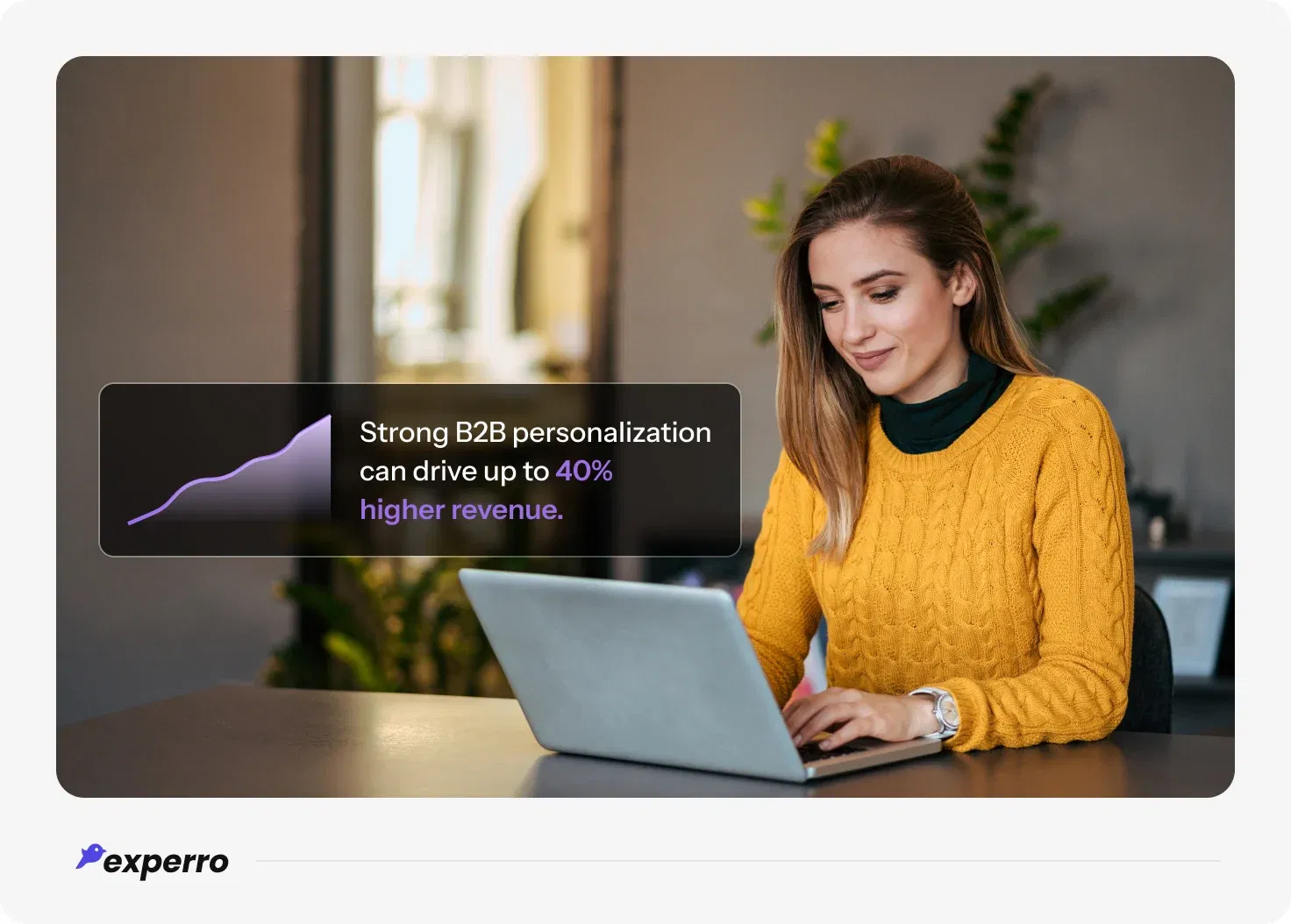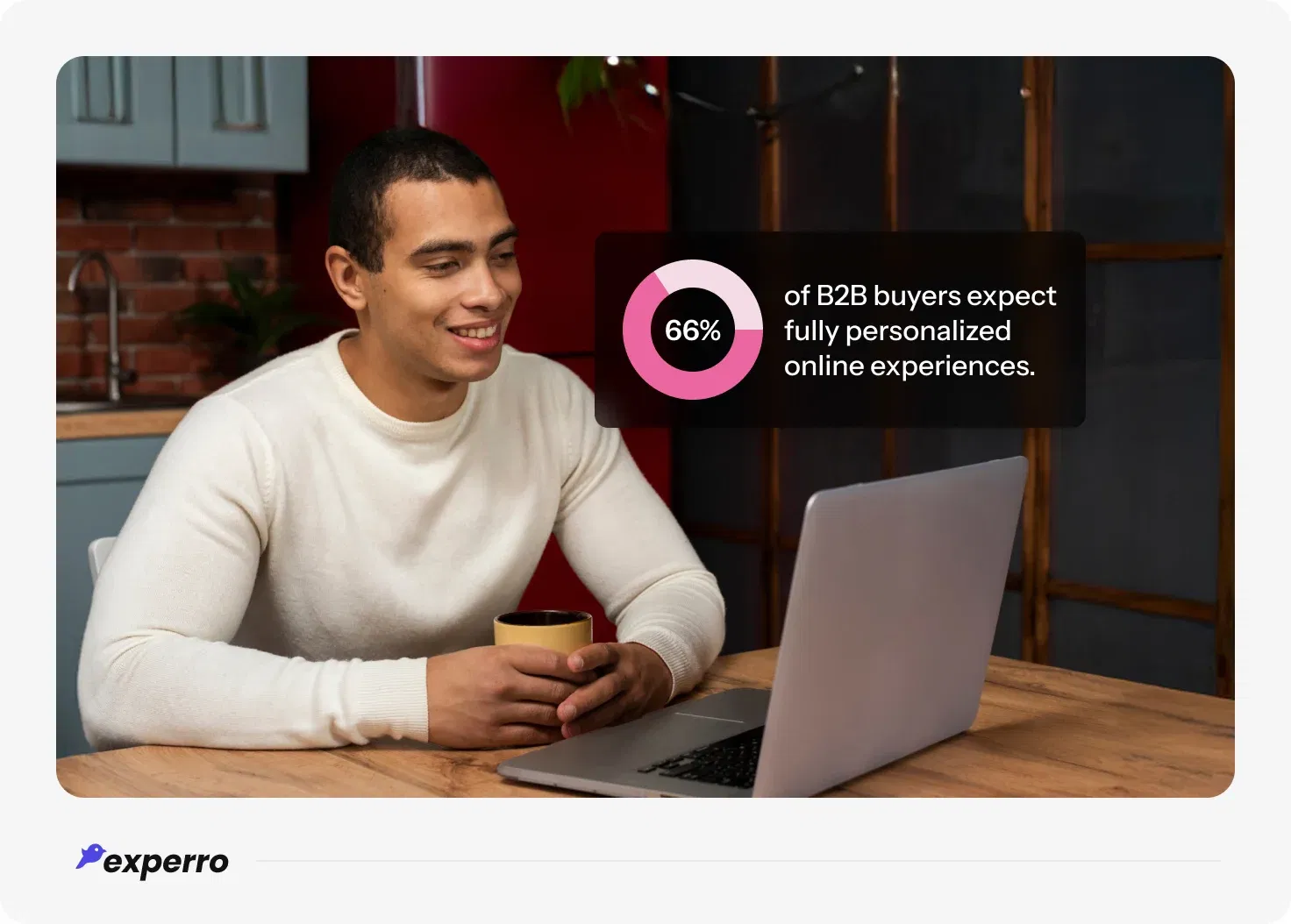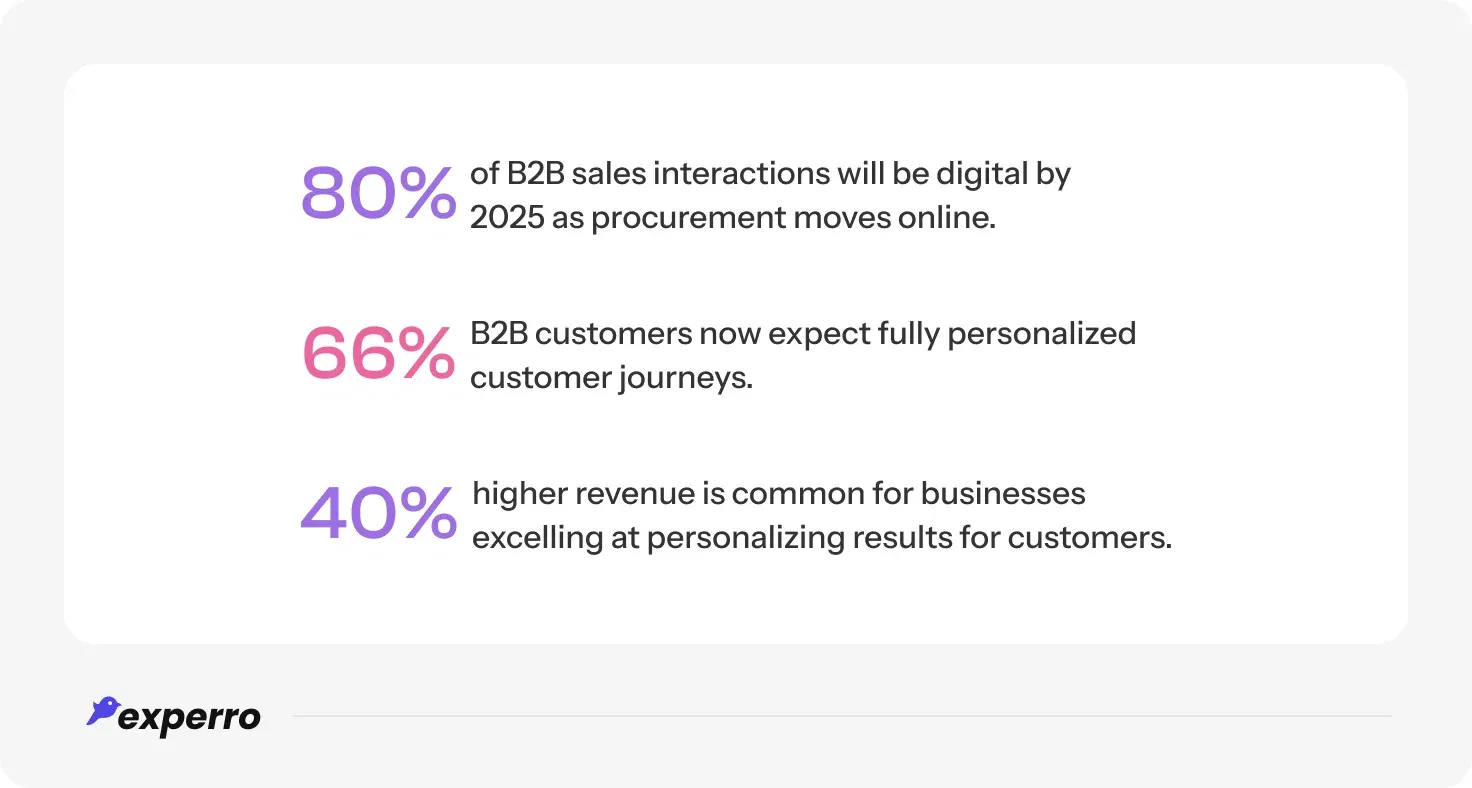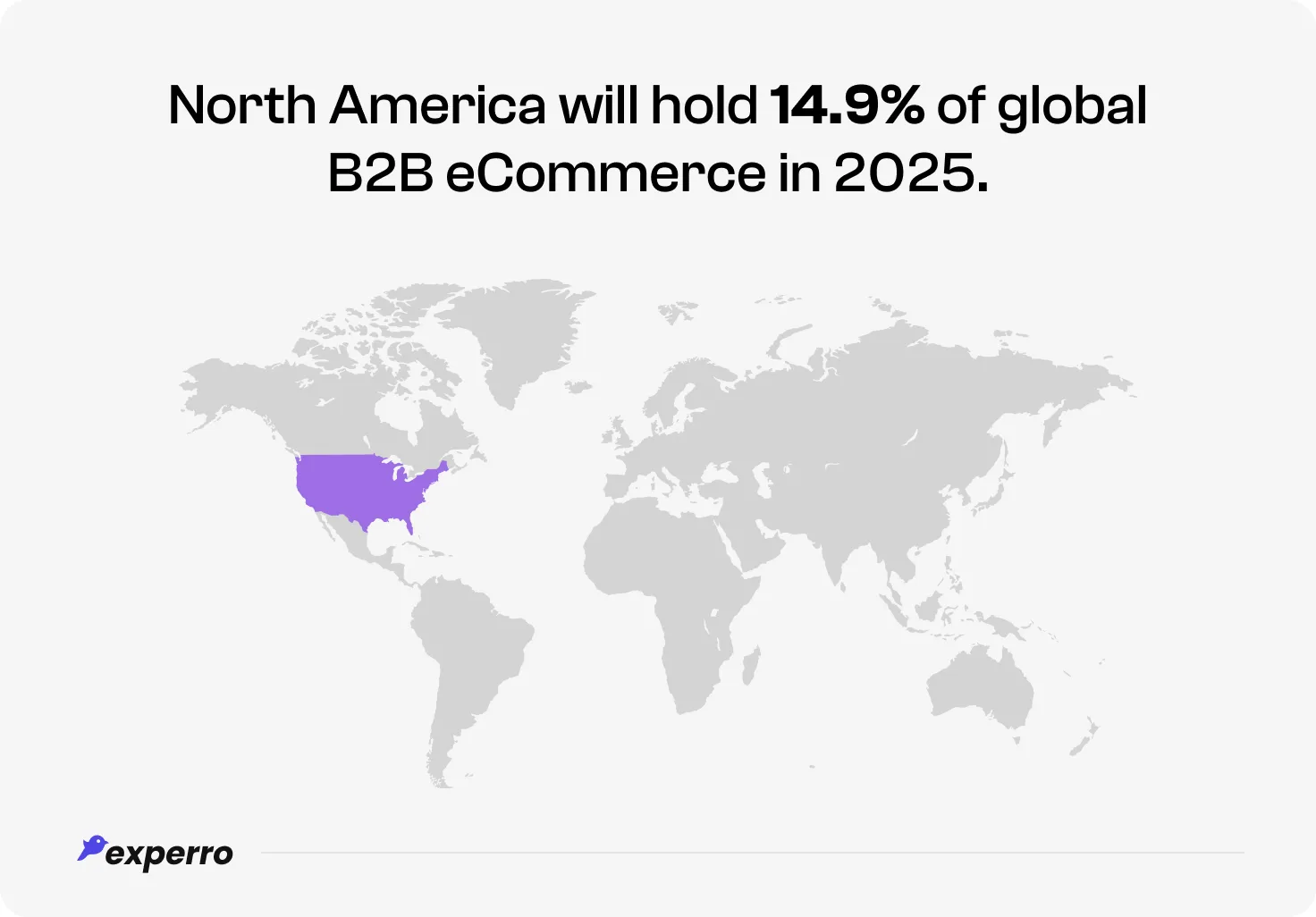core insights box
- The latest B2B eCommerce statistics prove that buyers now prefer online purchasing because it saves time, reduces friction, and offers better control over orders.
- The data shows that as buyer expectations increase; companies are upgrading their digital platforms and personalization capabilities to meet demand and retain customers.
- Experro elevates B2B product discovery with AI-powered search, dynamic catalogs, and personalized results, helping brands turn B2B eCommerce stats into a real competitive advantage.
Are you ready for the biggest shift B2B commerce has seen in years?
The B2B eCommerce market size 2025 is set to reach new heights as more businesses shift their buying processes online.
The latest B2B eCommerce stats show that digital B2B commerce revenue is expanding faster than expected.
From B2B vs B2C market size comparisons to soaring B2B eCommerce sales figures, the numbers reveal where smart businesses are headed next with streamlined transactions and cost savings.
Online adoption is rising fast, pushing companies to refresh their strategies to make the most of it.
B2B eCommerce replatforming statistics show a rising trend as businesses modernize their operations through technologies and digital platforms.
B2B eCommerce Statistics State What 2026 Looks Like...
The B2B commerce world is moving fast, leaving manual ordering and traditional in-person sales behind. Buyers now expect digital self-service, and businesses are adapting to meet those demands with self-service portals.
Looking at the statistics, we can see the B2B eCommerce trends and opportunities that will shape 2026 and influence customer behavior. Let’s take a look.
The Growth of B2B eCommerce and Digital Adoption
1. The global B2B ecommerce market size is estimated at US $32.11 trillion in 2025, growing to US $36.16 trillion by 2026. This jump adds over $4 trillion in new digital transaction volume in just one year, showing how aggressively businesses are moving online. 1
Such rapid B2B eCommerce growth signals a permanent shift where digital becomes the default procurement model worldwide, redefining sales channels and impacting supply chains.

2. The US B2B eCommerce market size reached approximately US $9.69 trillion in 2024, representing about 86.6 % of all US eCommerce. This momentum from 2024 is still shaping strategies in 2025, pushing businesses to strengthen their digital capabilities. 2
3. 73% of B2B buyers are now willing to place orders over US$50,000 through digital self-service channels. It shows the trust that shoppers have gained in online means of purchasing.
4. US digital channels projected to generate 56 % of US B2B revenue via online/self‑service in 2025, up from 32 % in 2020.
Crossing the 50% mark means digital officially becomes the primary revenue engine for US B2B companies, overtaking rep-led sales.
This shift shows that buyers now prefer instant access to inventory, pricing, and checkout without waiting for a salesperson. Companies slow to adopt digital self-service risk losing major revenue share to competitors offering a faster B2B buying process.
Want buyers to reach a decision faster?
B2B buyers are scanning for clarity. Give them a clean, structured product list that helps them confirm their choice quickly.
Evolving B2B Buyer Behavior and New Expectations
5. 73% of B2B buyers prefer to buy online, emphasizing the shift to self-service digital models and faster buying process expectations.
6. 61% of B2B buyers prefer a rep‑free and digital buying experience.
7. 64% of new‑age B2B buyers prefer digital channels over traditional ones for their procurement processes.
8. 75% of B2B buyers are ready to switch suppliers if they find a smoother and more intuitive online buying experience elsewhere. This shows how a strong digital UX design has become a competitive advantage.

This indicates that loyalty is no longer tied to long-term relationships, but it’s tied to digital performance. Poor search, slow load times, or outdated catalogs can instantly push buyers toward competitors.
In B2B, where order values are often 10x higher than B2C, losing even a single buyer due to bad UX has massive revenue consequences.
B2B Ordering & Conversion Insights
9. The average B2B company derives 82% of its revenue from digital sales (i.e., not in-person sales).
10. Companies that excel at personalization achieve conversion rate optimization up to 40% due to better use of customer data and data analytics.

This uplift becomes even more powerful in B2B where contracts are recurring, and average order values are extremely high. Personalization influences reorder frequency, cart size, and account-level retention.
It also improves the buyer experience by surfacing the right products, reducing procurement friction.
11. US B2B online ordering platforms (site sales) are projected to grow at 7.8 % annually from 2024 through 2028, reaching US $3.027 trillion by 2028. 3
12. 80% of B2B buyers use mobile devices at some point during their purchase process, highlighting the need for mobile‑first eCommerce websites.
Search and Personalization Shape the B2B Experience
13. In the B2B realm, 66% of buyers expect fully personalized content when shopping online. This demand pushes businesses to adopt machine learning, artificial intelligence, and dynamic pricing strategies.

B2B eCommerce personalization goes beyond recommendations, as it includes contract pricing, account-specific catalogs, negotiated terms, and role-based visibility.
Without this level of relevance, mid-cycle drop-offs and abandoned carts become more frequent. 4
14. A study found that top‑performing companies using B2B eCommerce search generate 40% more revenue than average, reinforcing the value of tailored search experiences.
15. 95% of B2B marketers believe personalization improves business outcomes, underscoring its centrality in the B2B ecommerce statistics space.
Technology, Mobility, and the Omnichannel Shift in B2B
16. 80% of B2B sales interactions will be digital by 2025, reflecting a global shift toward online procurement.
Meanwhile, 75% of buyers are ready to switch global suppliers for a better digital experience, making UX a decisive factor in loyalty.
Businesses that excel at personalization see up to 40% higher revenue, and 66% now expect fully personalized B2B customer journeys.

17. 65% of B2B websites prioritize mobile‑first experiences, reflecting the growing overlap of mobility and commerce in B2B. 5
18. 84% of B2B buyers want suppliers to offer several different sales channels (eCommerce websites, marketplaces, tele-sales, stores) to meet omnichannel expectations.
Global and Regional B2B eCommerce Outlook for 2026
19. North America is projected to hold 14.9 % of the global B2B eCommerce market in 2025 (reflecting the global vs regional split).
The region’s mature infrastructure, enterprise tech adoption, and focus on workflow automation continue to reinforce its global influence.

20. By 2026, 75% of Forbes’ G2000 (Global 2000) organizations will have deployed a digital-commerce platform for B2B buying and selling.
21. Asia-Pacific is set to command 80 % of the global B2B eCommerce statistics by 2026, while North America’s strength in high-value transactions and rapid digital adoption continues to power global B2B eCommerce market forecasts.
APAC’s dominance is driven by scale, by the world’s largest supplier networks, manufacturing hubs, and B2B eCommerce marketplaces. The region’s digital procurement tools and mobile-first buyer behavior are setting new global standards.
Meanwhile, North America leads the enterprise-grade platforms, high-value transactions, and digital workflows, shaping global B2B eCommerce strategy. 6
Want to understand how Experro can support your B2B growth?
We’ll walk you through the core features — fast, simple, and focused on real B2B use cases like search, catalog navigation, and workflows.
When B2B Demands More, Brands Choose Experro!
Most B2B platforms struggle with complex catalogs, slow search, and rigid workflows. Experro solves all of it with a modern agentic experience platform built for scale.
It’s engineered to help brands thrive in the expanding size of the B2B eCommerce industry.
With rising B2B eCommerce growth statistics and a rapidly shifting buyer landscape, Experro ensures faster B2B product discovery, smarter personalization, and smoother workflows.
As the current B2B eCommerce stats continue to accelerate, Experro helps brands stay ahead with a seamless, conversion-focused experience.
Conclusion
The shift toward digital commerce is accelerating across the global B2B eCommerce statistics, and businesses that act early will lead the next wave of transformation.
With rising expectations, companies rely more on meaningful B2B eCommerce industry statistics to guide smarter decisions.
Supported by clear B2B eCommerce market forecasts, brands can plan with confidence.
As your business prepares for what’s next, now is the time to build experiences that match the next generation of B2B buyers. Schedule a call with our experts for more guidance.
Sources
FAQs
How fast is the B2B eCommerce market growing?
The global B2B eCommerce is growing at a compound annual growth rate of about 14.5 percent through 2026, supported by rising adoption and cross-border transaction volume.
How big is the global B2B eCommerce market compared to B2C?
According to industry estimates, the global B2B eCommerce market size is expected to reach 32.1 trillion USD in 2025, which is several times larger than the B2C eCommerce market. The B2B vs B2C ecommerce market size gap continues to widen each year as more procurement activity moves online.
Which country has the largest B2B eCommerce market overview?
The United States contributes significantly, with the B2B eCommerce market size USA projected to reach about 10.1 trillion USD in 2025.
What is the projected market size of B2B eCommerce by 2030?
The global B2B eCommerce stats are projected to reach approximately 61.9 trillion USD by 2030, driven by increased online purchasing, marketplace expansion, and digital-first procurement models.
How much revenue will B2B eCommerce generate in the next 5 years?
Estimates indicate that B2B eCommerce revenue will grow from around 32 trillion USD in 2025 to more than 62 trillion USD by 2030, reflecting rapid scaling across digital channels and modernized procurement workflows.
Pallavi Dadhich
Content Writer @ ExperroPallavi is an ambitious author recognized for her expertise in crafting compelling content across various domains. Beyond her professional pursuits, Pallavi is deeply passionate about continuous learning, often immersing herself in the latest industry trends. When not weaving words, she dedicates her time to mastering graphic design.
